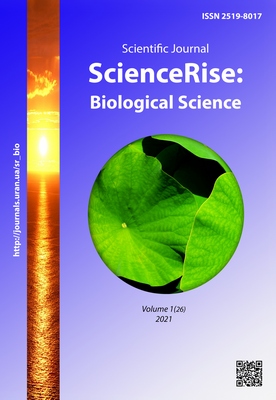Порівняння параметрів сперми та гістологічної структури сім’яників в жаби озерної (Pelophylax ridibundus) в районах з різним рівнем антропогенного забруднення
DOI:
https://doi.org/10.15587/2519-8025.2021.228082Ключові слова:
амфібії, параметри сперми, сім’яники, гістологічні зміни, сперматогенез, антропогенне забруднення, біоіндикаціяАнотація
Мета. Метою роботи було вивчення показників сперматогенезу у жаби озерної, Pelophylax ridibundus (Pallas, 1771), у зоні впливу викидів Бурштинської теплової електростанції (ТЕС).
Матеріали і методи. У самців амфібій з антропогенно забруднених територій відбирали зразки сперми та сім’яників. Такі параметри, як концентрація сперматозоїдів у еякуляті, кількість живих сперматозоїдів, загальна кількість активно рухливих форм та відсоток сперматозоїдів з прогресивним рухом обчислювали в гемоцитометрі. Гістологічні дослідження сім’яників проводили загальноприйнятими методами. На мікропрепаратах визначали діаметр сім’яних трубочок та відхилення у структурі паренхіми сім’яників.
Результати. У амфібій поблизу промислового майданчика Бурштинської ТЕС концентрація сперматозоїдів у зразку сперми, загальна кількість їх рухливих форм, а також діаметр сім’яних трубочок достовірно зменшуються. Разом з тим кількість загиблих сперматозоїдів достовірно збільшується. У земноводних з техногенно трансформованих екотопів спостерігали розширення сім’яних трубочок та спустошення їх вмісту.
Висновки. Вплив викидів Бурштинської ТЕС має виражений репротоксичний ефект, який проявляється депресивними змінами в тканині сім’яників та гаметах. Чоловіча репродуктивна система жаби озерної чутлива до забруднення навколишнього середовища. Параметри сперми та гістологічні зміни в сім’яниках є інформативними біомаркерами і можуть бути використані для біоіндикації техногенно трансформованих територій
Посилання
- Mima, M., Greenwald, D., Ohlander, S. (2018). Environmental Toxins and Male Fertility. Current Urology Reports, 19 (7), 49–57. doi: http://doi.org/10.1007/s11934-018-0804-1
- Reznikov, A. G. (2014). The view of a pathophysiologist-endocrinologist on the problem of age-related androgen deficiency in men (LOH syndrome). International Journal of Endocrinology, 6 (62), 11–18.
- Pankivskyi, Y. I., Oshurkevych-Pankivska, O. Y., Ostashuk, M. B. (2017). Assessment of burshtyn TPP impact on ambient air. Scientific Bulletin of UNFU, 27 (5), 59–62. doi: http://doi.org/10.15421/40270512
- Koshlak, N. V. (2019). Environmental hazard of the technogenic soil pollution with heavy metals for the impact areas of Burshtyn TPP. Naukovo-tekhnichnyi zhurnal, 2 (20), 7–14.
- Yaglova, N. V., Yaglov, V. V. (2012). Endocrine disruptors are a novel direction of endocrinologic scientific investigation. Annals of the Russian Academy of Medical Sciences, 67 (3), 56–61. doi: http://doi.org/10.15690/vramn.v67i3.186
- Rehman, S., Usman, Z., Rehman, S., AlDraihem, M., Rehman, N., Rehman, I., Ahmad, G. (2018). Endocrine disrupting chemicals and impact on male reproductive health. Translational Andrology and Urology, 7 (3), 490–503. doi: http://doi.org/10.21037/tau.2018.05.17
- Filatova, L. N. (2011). Structure morfofunktsionalnoj of characteristic seed plant of the nimble lizard and lake frog in the zone of influence of the enterprises of ferrous meta. Vestnik OGU, 16 (135), 225–226.
- Cao, H., Shi, C., Jia, X. (2012). Toxicity mechanism of Cadmium-induced reactive oxygen species and protein oxidation in testes of the frog Rana nigromaculata. Acta Ecologica Sinica, 32 (13), 4199–4206. doi: http://doi.org/10.5846/stxb201106020739
- Larenas, J., Jaque, M., Bustos-López, C., Robles, C., Lobos, G., Mattar, C., Valdovinos, C. E. (2014). Histopathological findings in Gonads of Xenopus laevis from Central Chile. Gayana (Concepción), 78 (1), 70–73. doi: http://doi.org/10.4067/s0717-65382014000100009
- Zhang, H., Liu, W., Chen, B., He, J., Chen, F., Shan, X. et. al. (2018). Differences in reproductive toxicity of TBBPA and TCBPA exposure in male Rana nigromaculata. Environmental Pollution, 243, 394–403. doi: http://doi.org/10.1016/j.envpol.2018.08.086
- World Health Organization (2010). WHO laboratory manual for the examination and processing of human semen. Cambridge: Cambridge University Press, 4–33.
- Shevliuk, N. N., Blinova, E. E., Bokov, D. A., Demina, L. L. (2008). Morfofunktsionalnaia kharakteristika organov razmnozheniia gryzunov iz populiatsii, nakhodiaschikhsia v zone vliianiia zavoda, pererabatyvaiuschego gaz s povyshennym soderzhaniem soedinenii sery. Morfologiia, 5, 43–47.
- Pizent, A., Tariba, B., Zivkovic, T. (2012). Reproductive toxicity of metals in men. Archives of Industrial Hygiene and Toxicology, 63, 35–46. doi: http://doi.org/10.2478/10004-1254-63-2012-2151
- Aloyan, K. A., Matveyev, A. V., Morev, V. V., Korneyev, I. A. (2013). Physiology of sperm motility. Urologicheskie Vedomosti, 3 (4), 14–19. doi: http://doi.org/10.17816/uroved3414-19
- Moreno, R. D., Reyes, J. G., Farías, J. G., Parada-Bustamante, A., Aguirre, V., Zepeda, A. B. et. al. (2012). Spermatogenesis at the extreme: Oxidative stress as a converging mechanism of testicular damage due to pathological and environmental exposure. Testis: Anatomy, Physiology and Pathology. New York: Nova Science, 1–24.
##submission.downloads##
Опубліковано
Як цитувати
Номер
Розділ
Ліцензія
Авторське право (c) 2021 Iryna Sluchyk, Bohdan Grytsulyak, Oksana Glodan, Iryna Ivasiuk, Alexandra Khallo

Ця робота ліцензується відповідно до Creative Commons Attribution 4.0 International License.
Наше видання використовує положення про авторські права Creative Commons CC BY для журналів відкритого доступу.
Автори, які публікуються у цьому журналі, погоджуються з наступними умовами:
1. Автори залишають за собою право на авторство своєї роботи та передають журналу право першої публікації цієї роботи на умовах ліцензії Creative Commons CC BY, котра дозволяє іншим особам вільно розповсюджувати опубліковану роботу з обов'язковим посиланням на авторів оригінальної роботи та першу публікацію роботи у цьому журналі.
2. Автори мають право укладати самостійні додаткові угоди щодо неексклюзивного розповсюдження роботи у тому вигляді, в якому вона була опублікована цим журналом (наприклад, розміщувати роботу в електронному сховищі установи або публікувати у складі монографії), за умови збереження посилання на першу публікацію роботи у цьому журналі.










